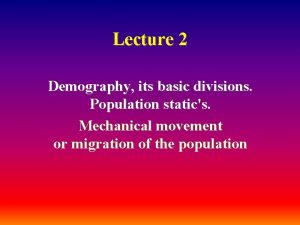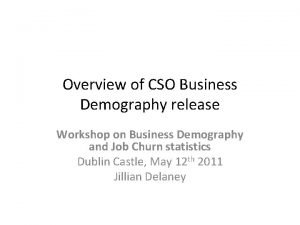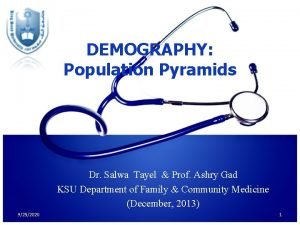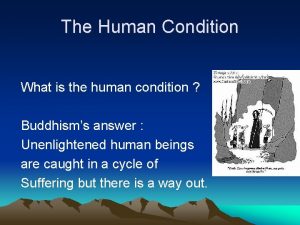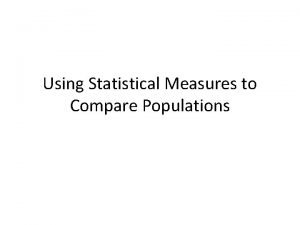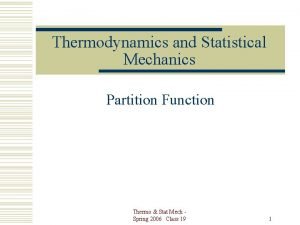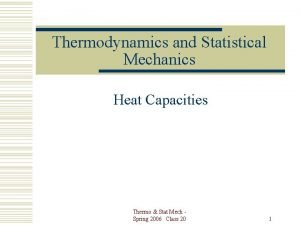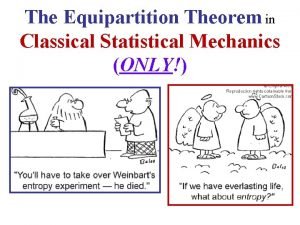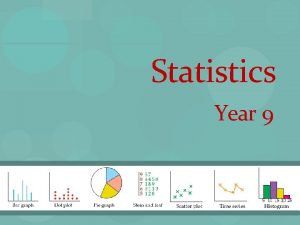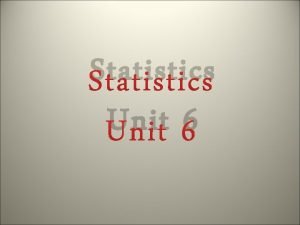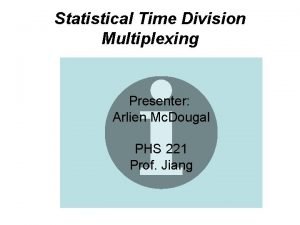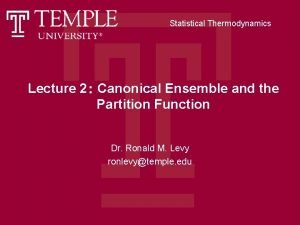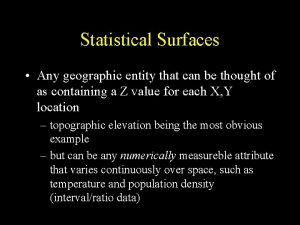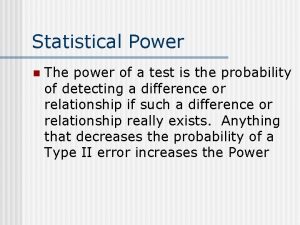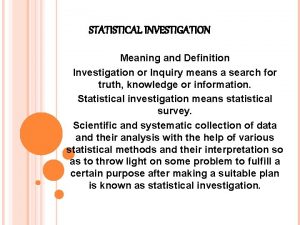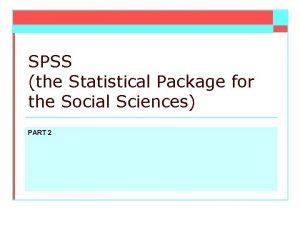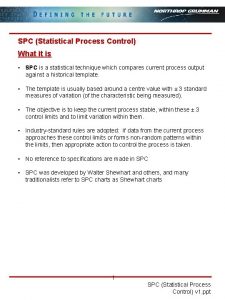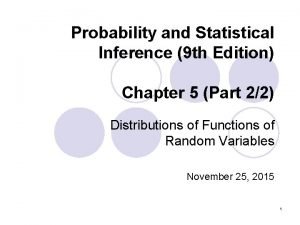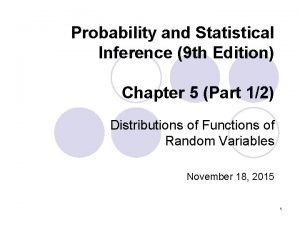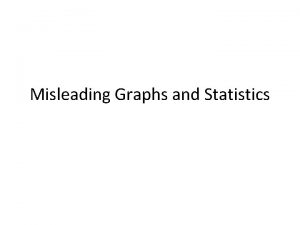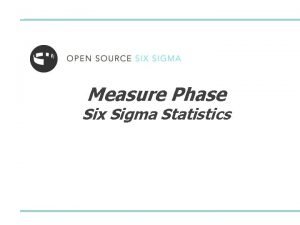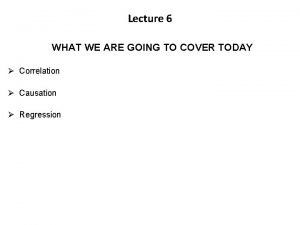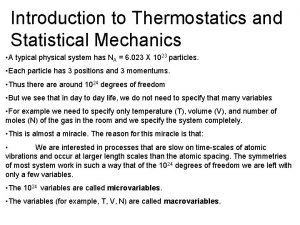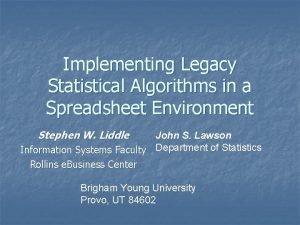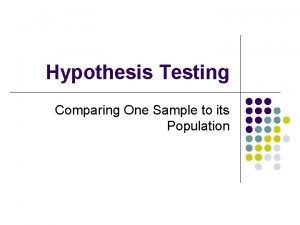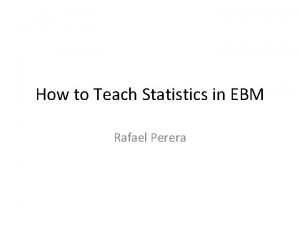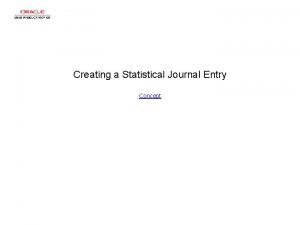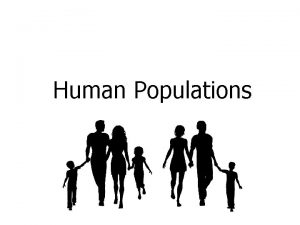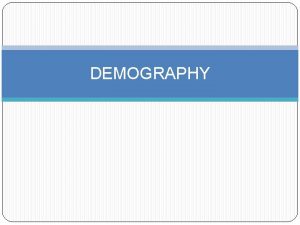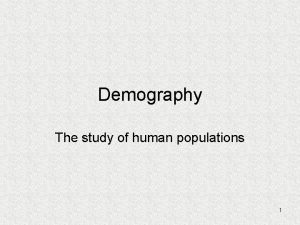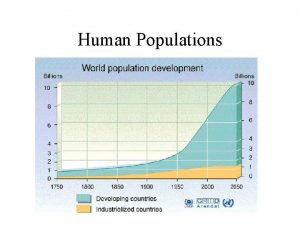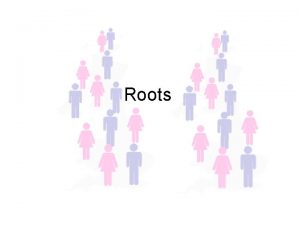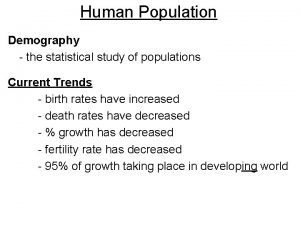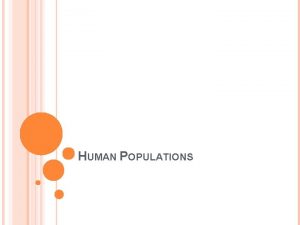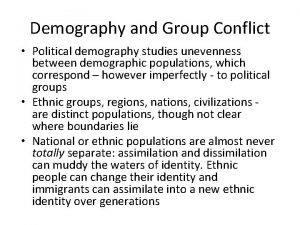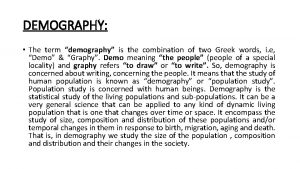V Statistical Demography Demography Statistical study of human




















































![Seen as follows: Estimation of c: the average of all observed k(t)-k(t-1) Since [k(t)-k(t-1)] Seen as follows: Estimation of c: the average of all observed k(t)-k(t-1) Since [k(t)-k(t-1)]](https://slidetodoc.com/presentation_image_h/0e169206f5c9899d3b648692502259d0/image-53.jpg)













- Slides: 66

V. Statistical Demography • Demography: Statistical study of human populations • By statistical: using the language of probability and statistical modeling for the population processes involved: mortality, fertility population projections • In this course, the topics: – Mortality – Life expectancy – Population projections 1

Mortality topics • Crude Death Rate – Annual number of deaths per 1000 • Standardized crude death rate • Age- and gender specific death rates • Probability of death • Mortality table, life table (dødelighetstabell) • Modeling mortality rates (population projections) 2

Crude death rate, CDR • • D = number of deaths during one given year P 0 = population size at January 1 P 1 = population size at December 31 A measure of mortality: Annual number of deaths pr. 1000 Mortality in the whole population regardless of age CDR can be misleading with comparisons in time and space, because it does not take into account the age structure in the population 3

Standardize CDR for age and gender • Example: – Norway 1950: CDR = 9, 13 – Norway 1987: CDR = 11, 14 • CDR has increased by 2 per 1000, but has really the mortality increased? • Age specific death rates in 1987 < 1950 for all ages • Explanation: Population is older in 1987! 4

Age specific death rate or mortality rate: Dx = number of deaths for agegroup x P 0, x and P 1, x : Size of population for agegroup x at the start- and endpopulation for age x 5

Standardized (hypothetical) CDR • CDR in a hypothetical population with 1950 age structure and 1987 age specific death rates • Alternatively: CDR in a hypothetical population with 1987 age structure and 1950 age specific death rates 6

Population 1987 with 1950 death rates: The hypothetical number of deaths in the age group x: Standardized CDR: 7

Population 1950 with 1987 death rates: The hypothetical number of deaths in the age group x: Standardized CDR: 8

Norway 1950 and 1987 standardized CDR N: mean population size in 1000 D: number of deaths, d = D/N per 10 000, s. d. = CDR 9

Comparison of observed and standardized mortality rates • Compare the four crude deaths rates (two unstandardized and two standarized) • How much of the difference between the CDR in 1950 and 1987 is due to: – Age strucuture – Mortality • The change in CDR of 2 per 1000 is the sum of these two components 10

Standardized CDR 1: CDR (Pop 87&mortality 50) – CDR(50): due to effect of age structure = 4, 64 2: CDR (87) – CDR (Pop 87&mortality 50): due to change in age specific mortality rates = - 2, 63 1. Change in age structure 13, 77 – 9, 13 = +4, 64 2. Change in age specific mortality 11, 14 – 13, 77 = -2, 63 3. Total = 1+2 4, 64 -2, 63 = 2, 01 ( = 11, 14 -9, 13) 11

Effect of changing factors • CDR increased by 2 from 1950 to 1987, but with constant age specific mortality it would have increased by 4, 64 – Effect of an aging population • The reduced age specific mortality has reduced the increase in CDR to only 2: 2, 6 reduced increase – Effect of lower age specific mortality 12

Alternative computation 1: CDR (Pop 50&mortality 87) – CDR(50): due to change in age specific mortality rates = -1, 94 2: CDR (87) – CDR (Pop 50&mortality 87): due to effect of age structure = 3, 95 1. Change in age specific mortality 7, 19 – 9, 13 = -1, 94 2. Change in age structure 11, 14 – 7, 19 = 3, 95 3. Total = 1+2 -1, 94+3, 95 = 2, 01 13

Some comments • Standardized rates will vary with the standard use and so will the quantitative conclusion • Can also control for gender • When comparing two countries: A third country age structure can be used as standard • Example: Mauritius vs England Wales with Japan age structure as standard 14

1. All age-specific death rates are higher in Mauritius for both men and women 2. Yet, unstandardized CDR is 6. 7 compared to 11. 3 for England Wales 3. Reason: Population in Mauritius is much younger 4. The standardized CDRs are 12. 20 for Mauritius and 7. 97 for England Wales, according to the age structure in Japan 15

Direct standardization • • Same age structures Different age specific mortality rates Here we ”control” for age, as in the previous example Another example: – CDR for Kuwait in 1996: 2. 18 per 1000 – CDR for United Kingdom (England, Wales, Scotland Northern Ireland): 10. 0 per 1000 – If we use UK 1996 age structure as standard: Kuwaits CDR is 12. 75 per 1000 16

Indirect standardization • • 1. 2. The most common approach in studies of mortality A standard of age specific death rates, combined with age structure ( f. ex. from censuses) Compute expected number of deaths based on actual age structure and standard age specific death rates Compute standardized mortality ratio (SMR) = observed number of deaths/ expected number of deaths SMR > 1: actual (but unknown) age specific death rates are higher than the standard SMR < 1: actual (but unknown) age specific death rates are lower than the standard 17

Example UK vs. Kuwait • • 1. 2. 3. 4. 5. UK 1996 CDR = 10. 0, Kuwait 1996 CDR = 2. 2 Standard age specific death rates: UK 1996 Compute expected number of deaths for Kuwait, based on Kuwaits age structure and standard death rates Result: 3459 Observed number of deaths: 3815 Standardized mortality ratio SMR = 3815/3459 = 1. 10 SMR >1: Age specific mortality in Kuwait must be higher than the standard UK 18

CDR Norway 1945 - 1990, number of deaths per 1000 19

Age specific death rates, Norway 1900 age 20

21

22

Probability of death P 0, x: number of persons alive at exact age x Dx = number of deaths for this agegroup x and P 1, x : population size for agegroup x at the end for age x q(x) = estimated probability of dying before the age of x+1 given that the person is alive at age x, the oneyear death probability If we observe Dx : 23

Let Dx, total be the total number of deaths for this agegroup If only aggregated numbers are available: q(x) is the ratio of Dx, total to the ”middle” population half-way: Age specific mortality rate 24

In either case: 25

Example Individual data: q(60) can be calculated directly Aggregated data, knows only P 0, P 1 and the total number of deaths during one year of this age group: first mortality rate m(x) and then q(x) 26

If m(x) = 0 then q(x) = 0, While if all die, m(x) = 2 and q(x) = 1 When all die: Dx = P 0, x and P 1, x = 0 and m(x) = P 0, x /(P 0, x/2) = 2. Then: q(x) = 2/(1+2/2) =1. Otherwise: q(x)< m(x) 27

Mortality table (life table) • First time: John Graunt in 1662 • A method for summarizing age dependent death rates/probabilities for a given year • A hypothetical cohort (for example 100 000 persons) experience deaths in accordance with the mortality rates: simulate the lifecareer to a table population (life table population) • Can answer several questions using a standard mortality table: – How many are alive after 1, 2, 3, …years? – What is the life expectancy ( forventet levealder)? – What are the chance of dying between to given ages? 28

Life expectancy • The number of years a person born today can be expected to live under the current age specific mortality rates. • Specifically: Given age specific death rates (or death probabilities) for ages 0, 1, 2, 3, … • Remaining life expectancy for a certain age x, under the current age specific death rates (death probabilities) for ages x, x +1, x + 2, … • Notation: ex for x = 0, 1, 2, … • Hence: e 0 is life expectancy at birth 29

NB! • • Life expectancy and remaining life expectancy is a hypothetical ( also called synthetical : kunstig) measure of mortality. Example: In 2012 in Norway, for male of age 64: e 64 = 19. 03 years. So 64 year old Norwegian men can expect to be 83. 03 years old – But mortality will decrease in the coming years so the true expected age will be higher than 83. 03 – • There is a difference between remaining life years based on synthetic mortality and cohort data ( real age) 30

Alternative expression: 31

Now, Hence, 32

Remaining life expectancy at age x: 33

Assume p(x) is specified for the ages x = 0, 1, 2, . . Approximation, assuming linearity of p(t) in each interval [x, x+1): This is the trapezoidal method of numerical integration 34

The trapezoidal method of numerical integration The function (in blue) is approximated by a linear function (in red) The area under the curve f(x) is approximated by a trapezoid (only two parallell lines), norsk: trapes 35

Applied to ex : 36

Estimation of p(x + t) = P(X > x + t), the probability of survival at age x +t. q(x) is the estimated probability of death at age x, i. e. , the probability of death between the ages of x and x +1 so the probablity of death before age x +t is the sum of q(k) for k = 0, …, x+t-1. Hence an estimate of the probability of survival at age x + t is given by: Based on these estimates, we can compute the number of persons alive at age x+t based on a hypothetical (synthetic) population of 100 000. 37

For example, assume q(0) = 2. 73 and q(1) = 0. 25 per 1000. Then an estimate of P(X>2) = 1 - (q(0) + q(1))= 0. 99702 Then the number of persons remaining alive at age 2 will be 100 000. 0. 99702 = 99702. Let Ix+t be the number of survivals at age x + t in the synthetic population of 100 000. Then It follows that 38

Estimated life expectancy This is obtained from a life table or mortality table 39

Mortality table 2008 Norway 40

60, 6% chance of reaching 83 40% chance of reaching 88 For a 90 year old, the chance of reaching the age of 100 = 2089/31274 = 6. 7%. 41

Computation of remaining life expectancy –some examples: 42

Construction of life table • • Compute the age specific mortality rates m(x) Compute q(x) = m(x)/[1+m(x)/2] Derive the estimated p(x + t) Derive Ix in the synthetic population of 100 000 – Start with I 0 = 100 000 • Compute the number of deaths dx at the same time as Ix • Finally compute estimated ex 43

Historic development of life expectancy at birth, estimated e 0 Women Men Increase in life expectancy every decade for Norway 1960 -1970 -1980 -1990 -2000 -2010 Women 1. 5 1. 7 0. 6 1. 7 2. 0 Men -0. 4 1. 1 2. 6 3. 1 44

45

Norway. Difference between men and women in e 0 1850 -2000 46

Record life expectancy: has increased approximately linearly the last 160 years (2, 5 year each decade) 47

Population projections: forecast life expectancy • Need to predict mortality rates in the future. Shall describe a method suggested by Lee-Carter (1992), the most used approach • To model and forecast mortality: Standard methods forecasting time series, together with a simple model for the age-time surface of the log of mortality. A forecast is produced for the probability distribution of each future age specific death rate • We have data of mortality rates for the years t = T 0, …, T 1 48

Lee-Carter model Hence, ea(x) is the geometric mean of m(x, t) over t a(x): age-specific constants describing the general pattern of mortality for the whole base period b(x)k(t) is an age(row) by time (column) matrix and the columns are proportional Hence, the model will fit the data well, if the columns of {log m(x, t)-a(x) } are close to proportional 49

k(t): index of the level of mortality capturing the main trend in death rates b(x): age-specific constants describing the relative speed of change in mortality at each age The model is undetermined, because if b(. ) and k(. ) are one solution, then so are b(. )c and k(. )/c for any constant c. 50

Estimation of the parameters in the Lee-Carter model Unique least squares (LS) estimates : LS estimates minimizes Under conditions: 51

Forecasting Having fitted the demographic model we need a model for the mortality index k(t) Typical model, in most applications: random walk with drift fits very well: The drift term c is usually negative and represents the linear trend in the change of k(t) while e(t)s represents the deviations from this linear trend as random fluctuations This corresponds to a constant rate of decline for m(x, t), reflecting a stable reduction of mortality 52
![Seen as follows Estimation of c the average of all observed ktkt1 Since ktkt1 Seen as follows: Estimation of c: the average of all observed k(t)-k(t-1) Since [k(t)-k(t-1)]](https://slidetodoc.com/presentation_image_h/0e169206f5c9899d3b648692502259d0/image-53.jpg)
Seen as follows: Estimation of c: the average of all observed k(t)-k(t-1) Since [k(t)-k(t-1)] are i. i. d with mean c and standard deviation s 53

54

Point forecasts of mortality rates 55

Stochastic forecasts of mortality Usually as basis for prediction intervals, 1000 simulations 56

Forecasting life expectancy For each t >T 1: Derive life table with Ix = the number of survivals at age x and use the formula for estimating ex Applied to US data 1900 -1989, from Lee-Carter (1992) Was an influenza epidemic in 1918, used an intervention model for k(t): 57

58

59

60

Applied to Norway, data from 1900 -2004. The simple Lee-Carter model did not fit the data satisfactorily. Needed to add one more b. k term in the model Then the model fits the data well 61

Keilman og Pham (2005), Økonomiske analyser 6/2005 62

Population size forecasts • Need also to forecast fertility rates, can use a Lee. Carter model • Need to forecast migration (emigration and immigration) 63

R-packages for survey sampling • Survey analysis in R: http: //r-survey. r-forge. r-project. org/survey/index. html 64

65

66
 Exclave ap human geography definition
Exclave ap human geography definition Static demography
Static demography Cso business demography
Cso business demography Elements of demography
Elements of demography Population demography definition
Population demography definition Sources of demographic data
Sources of demographic data Components of demography
Components of demography Demography antonym
Demography antonym Statistical thermodynamics is a study of
Statistical thermodynamics is a study of Ecological study vs cohort study
Ecological study vs cohort study Retrospective cohort study
Retrospective cohort study Work study definition
Work study definition Marty lobdell
Marty lobdell Phytogeographical regions of india map
Phytogeographical regions of india map Distinguish between time study and motion study
Distinguish between time study and motion study Differentiate between time study and motion study
Differentiate between time study and motion study Who was the first to objectively study the human condition
Who was the first to objectively study the human condition Sociology the study of human relationships textbook
Sociology the study of human relationships textbook Holt sociology the study of human relationships
Holt sociology the study of human relationships Systematic definition sociology
Systematic definition sociology Chapter 8 study guide human resources culture and diversity
Chapter 8 study guide human resources culture and diversity Chapter 8 test human resources culture and diversity
Chapter 8 test human resources culture and diversity Conflict perspective sociology
Conflict perspective sociology India baby tossing
India baby tossing What is the study of human and nonhuman features of earth
What is the study of human and nonhuman features of earth Sociology the study of human relationships
Sociology the study of human relationships Human vs non human bones
Human vs non human bones Chapter 8 human needs and human development
Chapter 8 human needs and human development Chapter 8 human needs and human development
Chapter 8 human needs and human development Gni definition ap human geography
Gni definition ap human geography Human and non human nouns
Human and non human nouns Gss fast stream
Gss fast stream Using statistical measures to compare populations
Using statistical measures to compare populations Partition function in statistical mechanics
Partition function in statistical mechanics Statistical mechanics
Statistical mechanics Equipartition theorem statement
Equipartition theorem statement Statistical displays
Statistical displays What is a statistical question 6th grade
What is a statistical question 6th grade Statistical time-division multiplexing
Statistical time-division multiplexing Partition function in statistical mechanics
Partition function in statistical mechanics Univariate analysis tests
Univariate analysis tests A statistical surface has a
A statistical surface has a Generating alpha meaning
Generating alpha meaning Statistical power table
Statistical power table Statistical natural language processing
Statistical natural language processing Statistical enquiry means
Statistical enquiry means Statistical package for social science
Statistical package for social science Statistical process control ppt
Statistical process control ppt Statistical symbols and meanings
Statistical symbols and meanings Probability and statistical inference 9th solution
Probability and statistical inference 9th solution Probability and statistical inference 9th solution pdf
Probability and statistical inference 9th solution pdf National academy of statistical administration
National academy of statistical administration Misleading graphs statistics
Misleading graphs statistics Statistical symbols and meanings
Statistical symbols and meanings Statistical methods of demand forecasting
Statistical methods of demand forecasting Deterministic vs statistical relationship
Deterministic vs statistical relationship Relation between partition function and internal energy
Relation between partition function and internal energy Statistical algorithms
Statistical algorithms Statistical computing environment
Statistical computing environment Formula for hypothesis testing
Formula for hypothesis testing Statistical test flow chart
Statistical test flow chart Gss competency framework
Gss competency framework Statistical methods of demand forecasting
Statistical methods of demand forecasting Statistical investigations unit 3 section a
Statistical investigations unit 3 section a Statistical journal entry example
Statistical journal entry example Types of statistical investigation
Types of statistical investigation Partition function in statistical mechanics
Partition function in statistical mechanics

